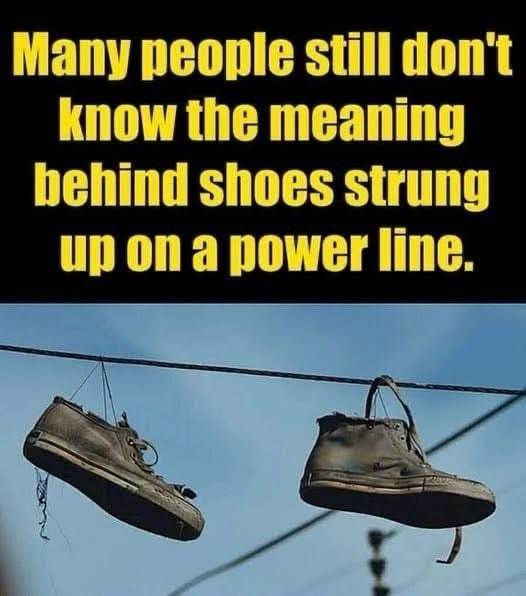
Although it’s not as commonly seen today, most people have come across the curious sight of sneakers tied together by their laces and tossed over power lines, dangling high above the street. It’s a strange and somewhat mysterious image that pops up in both urban neighborhoods and suburban areas. I used to assume it was nothing more than a childish prank—just a bit of mischief by bored teens with too much time and not enough supervision. But as I grew older and started to hear more stories, I realized that there are multiple theories behind this unusual phenomenon, and they span a surprising range of meanings and cultural interpretations.
One of the more widely circulated theories is that the practice originated with military traditions. According to this idea, soldiers returning from training camps or completing a tour of duty would tie their boots together and throw them over power lines or telephone wires as a symbolic gesture. It marked the end of a tough chapter, a way to let go of the grueling physical and mental trials they had endured. In that context, the boots weren’t just discarded footwear—they were a symbol of survival, perseverance, and transition. Over time, this practice may have found its way into civilian life, taking on new meanings far removed from its original intent.
Another popular belief—though largely unproven and often debated—is that shoes on power lines are connected to gang activity. Some people claim that shoes hanging from wires signify gang territory, drug-dealing locations, or even memorials for fallen members. This interpretation has been perpetuated in urban legends and films, although law enforcement agencies in many cities have denied any consistent connection between shoe tossing and organized crime. Still, the persistence of this theory speaks to the way people try to decode and assign meaning to public displays, especially ones that feel slightly eerie or out of place.
There’s also a more lighthearted, yet still troubling, explanation rooted in playground culture. In countless coming-of-age films and TV shows, there’s a recurring image: a kid gets bullied, and their shoes are taken and thrown somewhere they can’t reach—up onto a roof, into a tree, or over a set of wires. For those who’ve seen it in real life, it often sparks memories of schoolyard scuffles and the strange rituals of childhood dominance. In this context, the dangling sneakers represent humiliation and exclusion. The shoes become a kind of unspoken billboard that says someone lost, someone was picked on, someone didn’t quite belong.
Of course, some instances of shoes on power lines are nothing more than pranks or moments of spontaneous fun. Teens might toss shoes for laughs, to impress their friends, or to mark a random event—like the end of the school year or a dare gone right (or wrong). In college towns, it’s sometimes done to commemorate graduation, parties, or other milestone moments. The act can be symbolic or just plain silly, with no deeper meaning than a shared laugh and a moment of rebellion.
There’s also an artistic or expressive side to this act. In some places, hanging shoes have been incorporated into street art projects or urban storytelling efforts. Photographers and filmmakers have used the image to evoke a sense of place, identity, or nostalgia. For some, those sneakers are more than just abandoned footwear—they’re a canvas for memories, statements, and questions about who passed through that street and what their story was.
Ultimately, the meaning behind sneakers dangling from power lines varies depending on where you are and who you ask. In some communities, it’s a sign of celebration; in others, a somber marker of something lost. What’s fascinating is how a single visual—simple, common, and oddly haunting—can carry so many interpretations. Whether born out of tradition, rebellion, grief, or humor, those shoes tell a story, even if we can’t always be sure what the story is.

